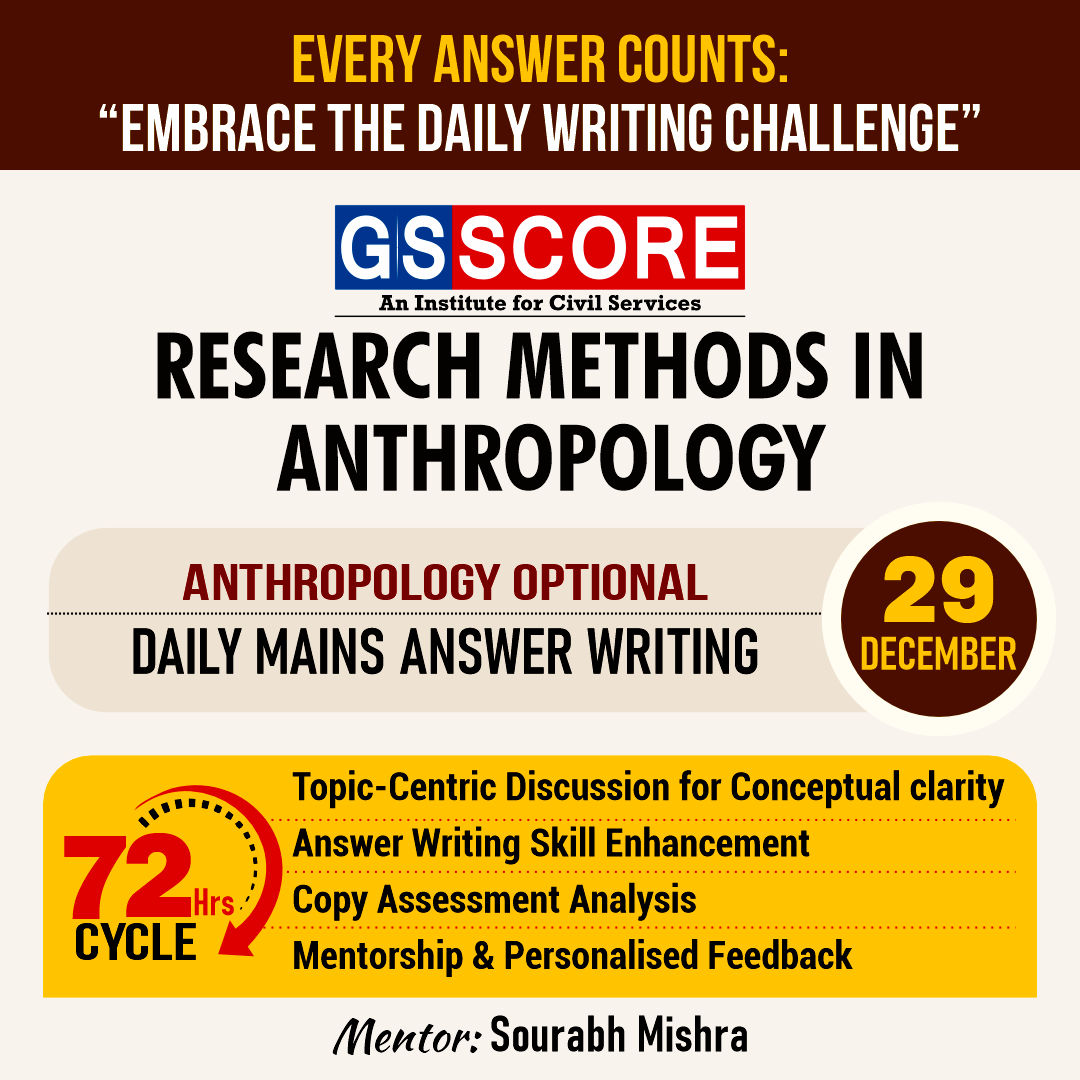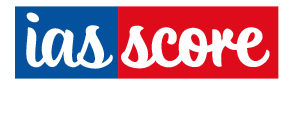


Instruction:
- There will be 2 questions carrying the First Question is-10 marks Write your answers in 150 words and the Second Question is-15 marks Write your answers in 250 words.
- Any page left blank in the answer-book must be crossed out clearly.
- Evaluated Copy will be re-uploaded on the same thread after 2 days of uploading the copy.
- Discussion of the question and one to one answer improvement session of evaluated copies will be conducted through Google Meet with concerned faculty. You will be informed via mail or SMS for the discussion.
Question #1. Discuss various tools of data collection in conducting anthropological research. 10 marks (150 words)
Question #2. Discuss the advantages and limitations of participant - observations as a technique of data collection. 15 marks (250 words)
(Examiner will pay special attention to the candidate's grasp of his/her material, its relevance to the subject chosen, and to his/ her ability to think constructively and to present his/her ideas concisely, logically and effectively).
STEPS & INSTRUCTIONS for uploading the answers
Step 1 - The Question for the day is provided below these instructions. It will be available at 7:00 AM.
Step 2 - Uploading of Answers : Write the answer in A4 Sheet leaving proper margins for comments and feedback and upload the PDF in MY ACCOUNT section. Click on the option of SUBMIT COPY to upload the PDF.
Step 3 - Deadline for Uploading Answers: The students shall upload their answers by 7:00 PM in the evening same day. The first 50 copies will be evaluated.
Step 4 - Feedback : Mentors will give their feedback for the answers uploaded. For more personalised feedback, join our telegram channel by clicking on the link https://t.me/mains_answer_writing_cse . A one-to-one session will be conducted with the faculty after copy evaluation in 72 Hrs.
Model Answer
Question #1. Discuss various tools of data collection in conducting anthropological research. 10 marks (150 words)
Approach
- Introduce the various tools of data collection in conducting anthropological research
- Questionnaires and its types- Merits & Demerits
- Interview and its types- Merits & Demerits
- Types of Schedules and its merits 5. Conclusion
Hints:
Introduction
Questionnaires and interviews are two important techniques adopted in anthropological research. Different tools are used while using these techniques. A schedule is a tool to conduct interviews or observations
- Questionnaires
– The questionnaire is considered the heart of a social survey because it is the main technique of data collection employed in the survey method. It is a better instrument for obtaining information about personal life, feelings, expectations, or future plans. Questionnaires are divided into a structured questionnaire, unstructured questionnaire, mixed questionnaire, and pictorial questionnaire.
–Structured questionnaire: In structured questionnaires, the questions are prepared in advance and not constructed on the spot during the question period. In this type of questionnaire, the same wording and same order are maintained for all respondents.
–Unstructured questionnaire: In unstructured questionnaires, the questions are not structured in advance. The questions may be adjusted according to the needs of the situation, with maximum flexibility to collect as much information as possible.
–Mixed questionnaire: A partly structured and partly unstructured questionnaire is called a mixed questionnaire. This has the quality of both types of questionnaires.
–Pictorial questionnaire: In the pictorial questionnaire, the selected alternative answers are given in the form of pictures.
Merits:
– Large coverage could be in a questionnaire.– Less expensive compared to other methods of research– It is easy to plan, construct and administer
Demerits:
– It would not be used to collect information from non-literate or less educated persons.– It could not ensure an adequate response rate.– Respondent can misinterpret a question or gives an incomplete answer.
- Interview The interview can be defined as a system in which both the investigator as well as the informant discuss the problem under research, the former usually taking the initiative with the object of extracting maximum information from the latter. According to Goode and Hatt, interviewing is fundamentally a process of social interaction
.– In simple terms, an interview means ‘conversation with a purpose.– It is a procedure used for collecting data through a person-to-person contact between an interviewer and respondent(s).
– In an interview, data collection is done mainly through the verbal interaction between the respondent(s) and the interviewer.
– The views and ideas of other persons can be elicited through interviews.– Interviews can be categorized based on different criteria:
- On the basis of persons involved, there are Individual interviews and group interviews.
- On the basis of the nature of the questions included, it could be classified as a structured interview (Formal interview) and an unstructured interview (Informal interview).
–Individual Interview: When an interview is confined to an individual informant it is called an individual interview or personal interview.
–Group interview: If a group of persons is interviewed for ascertaining their views and opinions, it is known as a group interview.
–Structured interview (Formal interview): The interview based on pre-determined questions and standardized techniques is called a structured interview
–Unstructured interview (Informal interview): The unstructured interview allows greater flexibility in the number, method, and sequence of questions. Depending upon the situation, more freedom is given to the interviewer to choose the form of questions.
Merits:
– It provides a safe basis for generalization. To a great extent, the interviewer’s bias can be reduced. It is also easy to administer.
– Depending upon the situation, more freedom is given to the interviewer to choose the form of questions.
– The interview can also be adjusted to the level and conditions of the respondent.
Demerits:
– The success of the interview depends upon how scientifically the interview is started, continued, and concluded.
– Interviewing is not an easy task. A lot of care and skill are required for the successful conduct of an interview.
– An interviewer may have to interview more than one person at a time.
– Moreover, the researcher may or may not interview an interviewee with pre-determined questions.
– Lot of subjectivity and individual feelings may creep in an interview.
- Schedule
A schedule is a set of questions asked and filled by the researcher. A schedule provides an opportunity to establish rapport with the respondent.
Types of Schedules:
Normally there are five types of schedules as explained below.
a) Observation Schedule: An Observation Schedule contains some specific aspect on which, the observer has to concentrate and collect information. For example, if an anthropological researcher has to collect details of food gathering and forest products by a given tribal group, an observation schedule can be prepared.
b) Document Schedule: This is used to collect data from official documents, autobiographies, and records.
c) Rating Schedules: These are used to measure attitudes, behavior, and opinions in psychological and sociological research.
d) Evaluation Schedules: These are used to get information about some institutions and agencies.
e) Interview Schedule: This is normally used as a synonym for Schedule. It contains questions to be asked by the researcher and space for recording answers. A household Schedule is a type of Interview Schedule widely used in anthropological field research to collect data on the demographic profile of households.
Merits:–
The researcher has a chance to explain the meaning of certain unclear items and the purpose clearly.
Conclusion: However, the entire activities of using tools and techniques are connected with research, including the methods of data collection which have to be planned well in advance. This is formalised through the preparation of a research design.
Question #2. Discuss the advantages and limitations of participant - observations as a technique of data collection. 15 marks (250 words)
Approach
- Introduce the observation
- Features of Observation
- The features of participant observation
- Merits of the participant observation
- Limitations of the participant observation
- Conclusion
Hints:
Introduction: Observing and being observed are two important features of modern society. In social research, one of the most important and extensively used methods is Observation. In the contemporary western world, people are under constant observation wherever they go.
Features of Observation:
- All observations are not scientific.
- An observation becomes scientific only if it is planned and executed systematically.
- It may take place in a real-life setting or in a laboratory.
- Herskovits, the American Anthropologist terms the field as the ‘ethnographer’s laboratory’
Several types of field observation have been used in anthropological research. A researcher can observe the day-to-day life of the group under study either by participating or without participating in it. Observation is divided mainly into two types: Uncontrolled observation and Controlled observation.
- Uncontrolled Observation is a form of observation made in the natural environment without being influenced by outside control or external factors. There are two types of uncontrolled observations, participant observation, and non-participant observation.
- Participant Observation: When the researcher actively participates in the activities of the group under investigation, it is known as participant observation.
- In the extreme level of participant observation, the researcher might conceal one’s identity. It can be called total participant observation.
The features of participant observation are detailed below:
- Takes part in the social events which she or he is observing.
- Assumes a role or undertakes a job that is acceptable in the given social context.
- Ensures that the observer’s presence in the group does not disturb the normal life of the group.
- Generally, lives, shares, and participates in the everyday life of the group.
- Associates with the group not as a researcher but as a full-fledged member of the group. L
- Observe the behaviour of the members of the community.
- Discerns the inter-action and relationship between them.
- Engages in conversation with them to find out their responses, meanings, and explanations of the events that occur.
- Studies the life of a community or social unit as a whole (holistic study).
The success of the participant observation depends on one’s skill and personality. The observer’s task is to place oneself in the best position for getting a complete and unbiased picture of the life of the community. Generally, participant observation is considered the king of uncontrolled observation.
Merits of the participant observation are:
- Help to acquire the information which is true and extensive.
- Observer gets the opportunity to observe the natural behaviour of the people or society.
- To get greater insight into the phenomenon. Limitations of the participant observation:
- No definite time can be predicted for a participant-observer required to spend with the group for collecting the right data.
- Observer may be biased or has an emotional attachment with a kind of ideology or thought process.
- All the phenomena and behaviour are not subjected to observation.
- For an effective collection of data, one could not maintain the objective of the research. The main aim of the data collection may be lost during the process.
- The resources like, time and money that are required to carry out participant observation is a major limitation as it needs more investment.
- Authenticity of Historical data collection during observation.
Conclusion:
Participant Observation is one form of data collection and it needs some precautions while used for data collection in the field. For eliminating its drawbacks, one should maintain objectivity, irrespective of developing a high level of proximity through a successful rapport establishment with the group in the course of one’s research.


